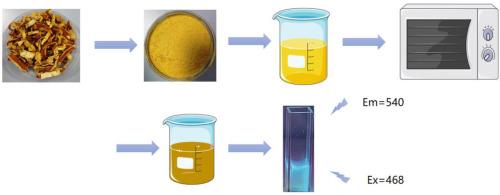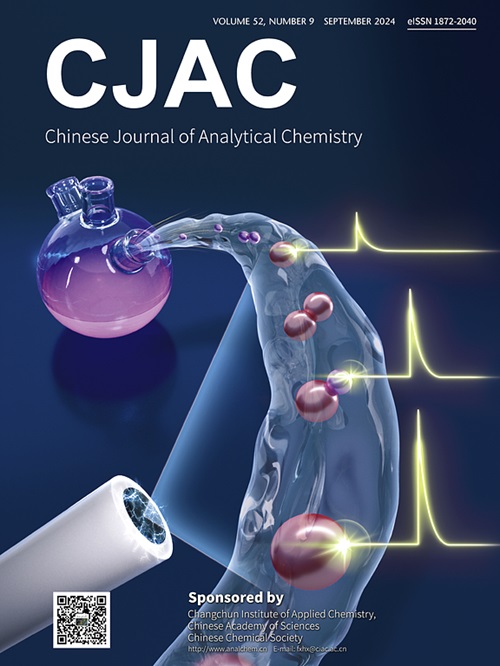Determination of tetracycline by FRET fluorescence between chenpi carbon quantum dots and copper nanoparticles
IF 1.3
4区 化学
Q4 CHEMISTRY, ANALYTICAL
引用次数: 0
Abstract
This paper describes a new strategy based on fluorescence resonance energy transfer (FRET), in which the rapid synthesis of carbon quantum dots (CQDs) and copper nanoparticles (CuNPs) is used for the determination of tetracycline (TC). Therefore, in this paper, CQDs for fluorescence determination of TC were prepared by microwave heating using chenpi as a carbon source. The prepared CQDs showed good dispersion and uniform spherical shape under transmission electron microscope (TEM), with an average particle size of about 1.91 nm. Under ultraviolet (UV) irradiation, the CQDs emitted bright blue-green fluorescence with a strong fluorescence (> 1.6 × 103 a.u.), and the fluorescence intensity did not change within one week. The emission wavelength of CQDs overlapped with the absorbance of CuNPs, and therefore, CuNPs could burst the fluorescence of CQDs by FRET mechanism. After incubation with TC, the fluorescence of CQDs was restored by the ligand reaction of CuNPs with TC. The assay showed good linearity for TC in the 1–100 nmol/L range, with a determination limit of 0.3554 nmol/L. This study demonstrated the potential of CQDs in antibiotic assays and provided a valuable method for monitoring TC levels.

利用陈皮碳量子点与纳米铜粒子之间的 FRET 荧光测定四环素
本文介绍了一种基于荧光共振能量转移(FRET)的新策略,即利用碳量子点(CQDs)和铜纳米颗粒(CuNPs)的快速合成来测定四环素(TC)。因此,本文以陈皮为碳源,通过微波加热制备了用于荧光测定四环素的碳量子点。制备的 CQDs 在透射电子显微镜(TEM)下显示出良好的分散性和均匀的球形,平均粒径约为 1.91 nm。在紫外线(UV)照射下,CQDs发出明亮的蓝绿色荧光,荧光强度较强(> 1.6 × 103 a.u.),且荧光强度在一周内无变化。CQDs 的发射波长与 CuNPs 的吸光度重叠,因此 CuNPs 可以通过 FRET 机制猝灭 CQDs 的荧光。与 TC 共同孵育后,CuNPs 与 TC 的配体反应使 CQDs 的荧光恢复。检测结果表明,TC 在 1-100 nmol/L 范围内线性关系良好,测定限为 0.3554 nmol/L。这项研究证明了 CQDs 在抗生素检测中的潜力,并为监测 TC 水平提供了一种有价值的方法。
本文章由计算机程序翻译,如有差异,请以英文原文为准。
求助全文
约1分钟内获得全文
求助全文
来源期刊
CiteScore
3.60
自引率
25.00%
发文量
17223
审稿时长
35 days
期刊介绍:
Chinese Journal of Analytical Chemistry(CJAC) is an academic journal of analytical chemistry established in 1972 and sponsored by the Chinese Chemical Society and Changchun Institute of Applied Chemistry, Chinese Academy of Sciences. Its objectives are to report the original scientific research achievements and review the recent development of analytical chemistry in all areas. The journal sets up 5 columns including Research Papers, Research Notes, Experimental Technique and Instrument, Review and Progress and Summary Accounts. The journal published monthly in Chinese language. A detailed abstract, keywords and the titles of figures and tables are provided in English, except column of Summary Accounts. Prof. Wang Erkang, an outstanding analytical chemist, academician of Chinese Academy of Sciences & Third World Academy of Sciences, holds the post of the Editor-in-chief.

 求助内容:
求助内容: 应助结果提醒方式:
应助结果提醒方式:


